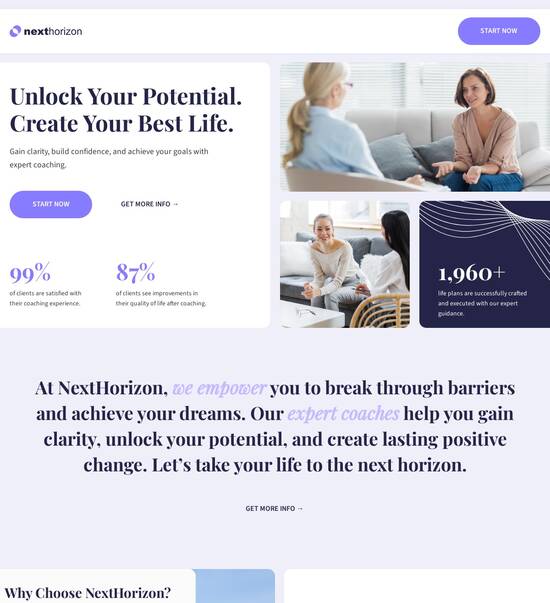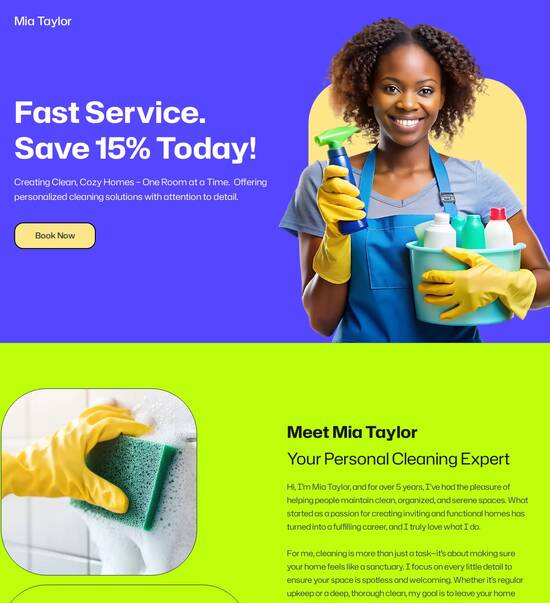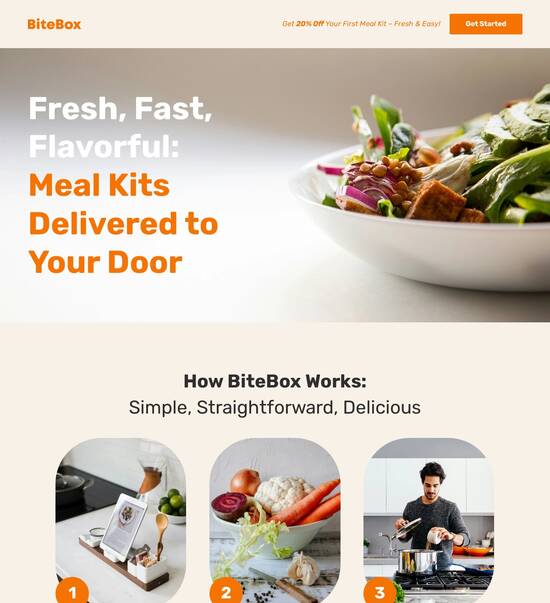
Web page template with interactive medical history form
Explore Similar TemplatesAbout template
Use web page templates with interactive medical history form and make your communications easy and transparent. Try our solution today.
Recommended templates

Easy to build without coding
With the intuitive drag-and-drop builder, anyone on your team can create high-converting pages without any knowledge of code or design. Make enhancements to your landing page with custom widgets using Javascript, HTML/CSS, or third-party scripts.

Multiple layouts for any industry and goal
Select from 500+ landing page layouts built to boost conversions across industry-specific scenarios. Customize them by adjusting fonts, adding images, and generating on-brand content with the AI assistant. Quickly scale with Instablocks® and Global Blocks that you can save, reuse, and update globally.

Loads fast and looks polished on any device
Every template is responsive, which means they present professionally on any device and load blazingly fast with our Thor Render Engine. You can also power them up with Google AMP technology to deliver an unparalleled mobile experience and drive higher conversions.

Robust analytics & experimentation
Get real-time updates and reporting across all your devices, showing the number of visitors, conversions, cost-per-visitor, and cost-per-lead. Launch AI-powered experiments, run A/B tests, and use heatmaps to analyze user behavior, then optimize your landing page to maximize conversions.







Easy to build without coding
With the intuitive drag-and-drop builder, anyone on your team can create high-converting pages without any knowledge of code or design. Make enhancements to your landing page with custom widgets using Javascript, HTML/CSS, or third-party scripts.
Multiple layouts for any industry and goal
Select from 500+ landing page layouts built to boost conversions across industry-specific scenarios. Customize them by adjusting fonts, adding images, and generating on-brand content with the AI assistant. Quickly scale with Instablocks® and Global Blocks that you can save, reuse, and update globally.
Loads fast and looks polished on any device
Every template is responsive, which means they present professionally on any device and load blazingly fast with our Thor Render Engine.
Robust analytics & experimentation
Get real-time updates and reporting across all your devices, showing the number of visitors, conversions, cost-per-visitor, and cost-per-lead. Launch AI-powered experiments, run A/B tests, and use heatmaps to analyze user behavior, then optimize your landing page to maximize conversions.
All the features you need to build lead-generating landing pages
Explore more featuresLearn how to build top-performing landing pages for any goal
FAQs
Leading the way in building high-performing landing pages





An effective landing page template for interactive forms
Creating an interactive medical history form is crucial for healthcare providers aiming to streamline patient intake processes. Instapage's tailored landing page templates allow marketers to effectively generate leads, and optimize user engagement while capturing essential patient information efficiently.
Understanding the importance of interactive forms
Interactive forms significantly enhance user experience and data accuracy. By using an engaging design, these forms reduce abandonment rates and increase completion rates. Studies indicate that forms that adapt to user input provide a more personalized experience, leading to higher patient satisfaction and conversion.
- Enhanced user engagement: Interactive elements keep users more engaged, leading to increased interaction times.
- Improved data accuracy: Users fill in required fields correctly when guided through interactive elements.
- Higher conversion rates: A well-optimized form structure can lead to up to a 30% increase in form completions.
Step 1: Selecting the right Instapage template
Choose from over 100 conversion-oriented templates that align with your campaign goals. Instapage offers a variety of customizable landing pages specifically designed to facilitate smooth execution of interactive medical history forms.
- Choose templates with built-in lead generation components: These templates often include fields specifically designed to capture medical history.
- Utilize templates with intuitive design for seamless user navigation: Focus on designs that make form-filling straightforward and enjoyable.
- Incorporate personalization features to cater to specific patient demographics: This includes dynamic text replacement to inform users based on their unique contexts.
Step 2: Customizing the interactive form
Tailor each element of the form to suit patient needs and to comply with privacy regulations. Leverage Instablocks to easily manipulate sections or fields without needing a coding background.
- Add field types that enhance usability: Multi-step forms or conditional logic fields can help in gathering intricate medical histories without overwhelming users.
- Ensure fields comply with HIPAA guidelines: Any collected data should adhere to privacy standards to maintain patient confidentiality.
- Incorporate clear instructions and tooltips: Users will feel more confident and informed, reducing the likelihood of errors during completion.
Step 3: Testing and optimizing the form
Before launching your interactive medical history form, it’s essential to test all functionalities for seamless user experience. Utilize A/B testing features within Instapage to optimize the form for better performance.
- Conduct user testing for subjective feedback: This would provide insights on design and flow improvements.
- Analyze performance with heatmaps and analytics: Understand how users interact with the form to identify areas needing adjustment.
- Adjust based on real data outcomes: Keep optimizing your form to reflect which elements lead to the most successful completions.
Developing an interactive medical history form with Instapage not only simplifies patient intake but also ensures data is collected efficiently and effectively.
Ready to enhance your patient experience? Start using Instapage today and transform your interactive forms into powerful lead-generation tools.
People also ask about Web page template with interactive medical history form
The evolution of patient interaction: harnessing an interactive medical history form template
Revolutionizing patient intake processes
The transition from paper to digital forms marks a significant shift in how healthcare providers interact with patients during the intake process. Traditionally, patients were required to fill out lengthy paper forms, leading to slow processing times and often inaccurate data entry. Digital forms have transformed this paradigm, enhancing efficiency and accuracy while minimizing the frustrations associated with paper forms.
One of the primary advantages of digital forms is their ability to streamline data entry through pre-defined fields and drop-down menus, reducing the likelihood of human error. Furthermore, the use of an interactive medical history form allows for dynamic updates, where information adjusts based on user input, significantly improving the quality of collected data.
Increased accuracy: Minimizes manual data entry errors.
Faster processing times: Quick access to patient information.
Enhanced patient engagement: Interactive features make the process more user-friendly.
Understanding health history data
Health history data holds immense significance in patient care. It encompasses a comprehensive record of a patient’s medical history, including past illnesses, surgeries, medications, allergies, and family health history. The collection and analysis of this data are crucial for healthcare providers to deliver tailored treatment and understand potential health risks.
Key components of health history data not only provide insight into past treatment but also help in making informed decisions regarding future interventions. By utilizing an interactive medical history form template, healthcare providers can ensure that they gather all necessary components systematically, leading to a more thorough understanding of each patient’s health.
Designing the interactive medical history form
Creating a high-performing interactive medical history form necessitates careful consideration of various essential fields. At a minimum, key fields must include patient details, such as name and contact information, a section for medical history, medication lists, and any known allergies. What truly sets an interactive form apart, however, are dynamic entry fields that adapt based on previous responses.
Additionally, incorporating patient education resources within each form can further benefit users by providing immediate access to relevant health information. This could include links to articles about managing specific conditions or explanations of medical terminology used within the form.
Patient details: Essential for identification.
Medical history: Comprehensive details improve continuity of care.
Allergies section: Crucial for safe treatment planning.
User experience: crafting an engaging interface
User experience (UX) is a key factor in ensuring that patients feel comfortable and engaged when filling out an interactive medical history form. Intuitive design plays a vital role, as forms should be easy to navigate and visually appealing. High-contrast color schemes, straightforward iconography, and logical flow will guide users through the process effortlessly.
Visual elements can also enhance engagement; for instance, using interactive sliders for age or graphical timelines for medical history can make the experience more interactive. The goal is to create an environment where patients feel guided rather than overwhelmed, increasing the likelihood of accurate data submission.
Advanced features driving efficiency
Ensuring HIPAA compliance and data security is paramount when dealing with patient information. Healthcare providers must prioritize the security of sensitive data to maintain patient trust and avoid potential penalties. Implementing robust encryption protocols and secure socket layer technology can significantly enhance data protection measures.
Additional features like two-factor authentication and access controls further enhance data integrity, ensuring that only authorized personnel can access specific information. Ultimately, a secure interactive medical history form will not only protect patient privacy but also streamline data collection.
HIPAA compliance: Essential for legal protection.
Data encryption: Ensures privacy during data transmission.
Access controls: Limits access to sensitive data on a need-to-know basis.
Seamless data capture and integration
The interactive medical history form's design should facilitate seamless data capture, storing the information efficiently for healthcare providers to access. By integrating this form with existing Electronic Health Records (EHR) systems, providers can ensure that all necessary patient history is readily available. This integration reduces duplicate entries and enhances data accuracy.
Moreover, the ease of access to historical information enables providers to make more informed decisions about patient care. Effectively bridging the gap between collection and application of health history data sets the foundation for a more proactive approach to healthcare.
Optimizing for multiple devices
In an era where smartphones and tablets dominate user experience, ensuring that the interactive medical history form is responsive across various platforms is critical. Mobile-friendly designs cater to patients who may prefer completing forms on their devices, facilitating easier data entry. Careful user testing on different devices ensures the form maintains functionality and aesthetics regardless of the screen size.
Equally important are accessibility considerations to cater to all patients, including those with disabilities. Designing forms that comply with the Web Content Accessibility Guidelines (WCAG) allows for inclusivity and ensures everyone can engage with their healthcare processes effectively. Features such as text-to-speech technology and alternative text for images can boost accessibility.
Mobile-friendly: Adapts to devices for easy access.
Regular user testing: Ensures functionality remains consistent.
Accessibility features: Inclusive design for all patients.
Impact on healthcare practices
Interactive medical history forms bring profound operational benefits to healthcare providers. By streamlining the intake process, these forms significantly reduce administrative workload, allowing staff to focus more on patient care rather than paperwork. The automation of collecting and managing patient data frees up time and resources, transforming how healthcare providers operate.
Furthermore, with pre-registered patient data at their fingertips, appointment scheduling becomes more accurate, thereby enhancing the overall patient experience. Case studies have shown that practices implementing interactive forms report a notable decrease in waiting times and an increase in patient satisfaction, underscoring the positive influence these forms have on healthcare efficiency.
Reduced administrative workload: Automation streamlines tasks.
Enhanced scheduling accuracy: Reliable data leads to better appointments.
Positive patient feedback: Higher satisfaction through improved processes.
Improved patient outcomes through efficient history capture
Measuring the impact of interactive medical history forms on patient outcomes is paramount. Several case studies reveal tangible improvements in care quality as a direct result of accurate and comprehensive data collection. Providers who utilize these forms often report timely interventions, leading to better management of chronic conditions and enhanced patient education.
Testimonials from healthcare professionals also emphasize the benefits of transitioning to interactive forms. Many report improved communication with patients and a heightened ability to customize treatments based on a patient’s specific health history.
Analyzing data for continuous improvement
By leveraging patient data collected through interactive medical history forms, healthcare providers can conduct meaningful trend analyses. This data can inform not only patient-specific treatment plans but also broader strategies for enhancing care and addressing community health needs. Tools for analytics and reporting enable practices to visualize patterns, helping improve care standards continuously.
Moreover, engaging patients in their health journey can lead to improved outcomes. Allowing patients access to their health history and changes promotes a sense of ownership, motivating them to participate proactively in their healthcare decisions. Simple strategies such as reminders for follow-ups or educational content on their conditions can keep patients informed and involved.
Trend analyses: Use data to identify treatment patterns.
Continuous improvement: Enhance care standards based on feedback.
Patient engagement: Foster ownership and accountability in health.
Resources and support for healthcare providers
Healthcare providers who aim to implement interactive medical history forms can benefit from educational resources and training guides. Designing customizable templates tailored to specific practice needs can provide a solid foundation for staff to engage with patients more efficiently. Having user-friendly documentation aids in the smooth transition from traditional methods to innovative digital solutions.
Moreover, establishing collaborative networks among healthcare professionals can foster an environment of shared learning. By sharing best practices and insights across industries, providers can stay informed of the latest trends and challenges in patient intake methods, building a community committed to improving health outcomes.
Training guides: Essential for seamless adoption of new technologies.
Customizable templates: Adaptable solutions for varied practices.
Collaborative networks: Learning from others’ experiences drives innovation.
Future trends in healthcare forms and patient engagement
Looking ahead, the integration of automation and AI in medical forms holds promise for improving patient interactions. Emerging technologies can enhance patient intake processes by predicting needs based on historical data patterns. Implementing AI could streamline the process even further, allowing patients to receive immediate responses to their inquiries.
Additionally, expanding the scope of interactive functions to include telehealth solutions during the intake process can set new standards in patient engagement. Innovative features beyond traditional forms will enhance user experience and improve accessibility, ensuring healthcare practices stay abreast of evolving patient needs.
AI integration: Predict patient needs for personalized care.
Telehealth solutions: Expanding ways to engage patients digitally.
Innovative features: Develop new capabilities for improving interactions.
Ready to skyrocket conversions?
Supercharge your ad campaigns with high-performing landing pages
Get started














